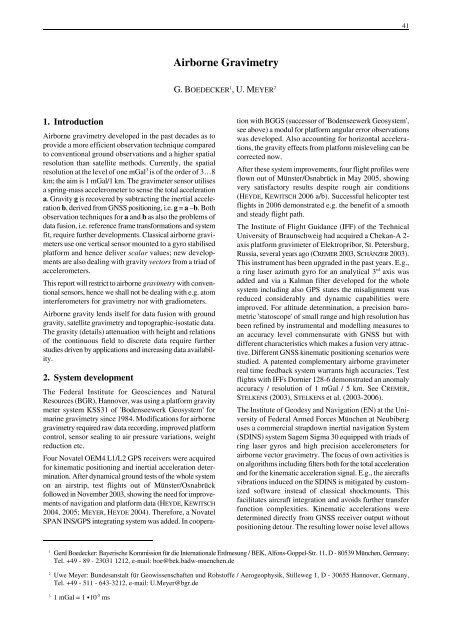NATIONAL REPORT OF THE FEDERAL REPUBLIC OF ... - IAG Office
NATIONAL REPORT OF THE FEDERAL REPUBLIC OF ... - IAG Office
NATIONAL REPORT OF THE FEDERAL REPUBLIC OF ... - IAG Office
You also want an ePaper? Increase the reach of your titles
YUMPU automatically turns print PDFs into web optimized ePapers that Google loves.
1. Introduction<br />
Airborne gravimetry developed in the past decades as to<br />
provide a more efficient observation technique compared<br />
to conventional ground observations and a higher spatial<br />
resolution than satellite methods. Currently, the spatial<br />
resolution at the level of one mGal3 is of the order of 3…8<br />
km; the aim is 1 mGal/1 km. The gravimeter sensor utilises<br />
a spring-mass accelerometer to sense the total acceleration<br />
a. Gravity g is recovered by subtracting the inertial acceleration<br />
b, derived from GNSS positioning, i.e. g = a –b. Both<br />
observation techniques for a and b as also the problems of<br />
data fusion, i.e. reference frame transformations and system<br />
fit, require further developments. Classical airborne gravimeters<br />
use one vertical sensor mounted to a gyro stabilised<br />
platform and hence deliver scalar values; new developments<br />
are also dealing with gravity vectors from a triad of<br />
accelerometers.<br />
This report will restrict to airborne gravimetry with conventional<br />
sensors, hence we shall not be dealing with e.g. atom<br />
interferometers for gravimetry nor with gradiometers.<br />
Airborne gravity lends itself for data fusion with ground<br />
gravity, satellite gravimetry and topographic-isostatic data.<br />
The gravity (details) attenuation with height and relations<br />
of the continuous field to discrete data require further<br />
studies driven by applications and increasing data availability.<br />
2. System development<br />
The Federal Institute for Geosciences and Natural<br />
Resources (BGR), Hannover, was using a platform gravity<br />
meter system KSS31 of 'Bodenseewerk Geosystem' for<br />
marine gravimetry since 1984. Modifications for airborne<br />
gravimetry required raw data recording, improved platform<br />
control, sensor sealing to air pressure variations, weight<br />
reduction etc.<br />
Four Novatel OEM4 L1/L2 GPS receivers were acquired<br />
for kinematic positioning and inertial acceleration determination.<br />
After dynamical ground tests of the whole system<br />
on an airstrip, test flights out of Münster/Osnabrück<br />
followed in November 2003, showing the need for improvements<br />
of navigation and platform data (HEYDE, KEWITSCH<br />
2004, 2005; MEYER, HEYDE 2004). Therefore, a Novatel<br />
SPAN INS/GPS integrating system was added. In coopera-<br />
1 Gerd Boedecker: Bayerische Kommission für die Internationale Erdmesung / BEK, Alfons-Goppel-Str. 11, D - 80539 München, Germany;<br />
Tel. +49 - 89 - 23031 1212, e-mail: boe@bek.badw-muenchen.de<br />
2 Uwe Meyer: Bundesanstalt für Geowissenschaften und Rohstoffe / Aerogeophysik, Stilleweg 1, D - 30655 Hannover, Germany,<br />
Tel. +49 - 511 - 643-3212, e-mail: U.Meyer@bgr.de<br />
3 1 mGal = 1 C10 -5 ms<br />
Airborne Gravimetry<br />
G. BOEDECKER 1 , U. MEYER 23<br />
41<br />
tion with BGGS (successor of 'Bodenseewerk Geosystem',<br />
see above) a modul for platform angular error observations<br />
was developed. Also accounting for horizontal accelerations,<br />
the gravity effects from platform misleveling can be<br />
corrected now.<br />
After these system improvements, four flight profiles were<br />
flown out of Münster/Osnabrück in May 2005, showing<br />
very satisfactory results despite rough air conditions<br />
(HEYDE, KEWITSCH 2006 a/b). Successful helicopter test<br />
flights in 2006 demonstrated e.g. the benefit of a smooth<br />
and steady flight path.<br />
The Institute of Flight Guidance (IFF) of the Technical<br />
University of Braunschweig had acquired a Chekan-A 2axis<br />
platform gravimeter of Elektropribor, St. Petersburg,<br />
Russia, several years ago (CREMER 2003, SCHÄNZER 2003).<br />
This instrument has been upgraded in the past years. E.g.,<br />
a ring laser azimuth gyro for an analytical 3rd axis was<br />
added and via a Kalman filter developed for the whole<br />
system including also GPS states the misalignment was<br />
reduced considerably and dynamic capabilities were<br />
improved. For altitude determination, a precision barometric<br />
'statoscope' of small range and high resolution has<br />
been refined by instrumental and modelling measures to<br />
an accuracy level commensurate with GNSS but with<br />
different characteristics which makes a fusion very attractive.<br />
Different GNSS kinematic positioning scenarios were<br />
studied. A patented complementary airborne gravimeter<br />
real time feedback system warrants high accuracies. Test<br />
flights with IFFs Dornier 128-6 demonstrated an anomaly<br />
accuracy / resolution of 1 mGal / 5 km. See CREMER,<br />
STELKENS (2003), STELKENS et al. (2003-2006).<br />
The Institute of Geodesy and Navigation (EN) at the University<br />
of Federal Armed Forces München at Neubiberg<br />
uses a commercial strapdown inertial navigation System<br />
(SDINS) system Sagem Sigma 30 equipped with triads of<br />
ring laser gyros and high precision accelerometers for<br />
airborne vector gravimetry. The focus of own activities is<br />
on algorithms including filters both for the total acceleration<br />
and for the kinematic acceleration signal. E.g., the aircrafts<br />
vibrations induced on the SDINS is mitigated by customized<br />
software instead of classical shockmounts. This<br />
facilitates aircraft integration and avoids further transfer<br />
function complexities. Kinematic accelerations were<br />
determined directly from GNSS receiver output without<br />
positioning detour. The resulting lower noise level allows











